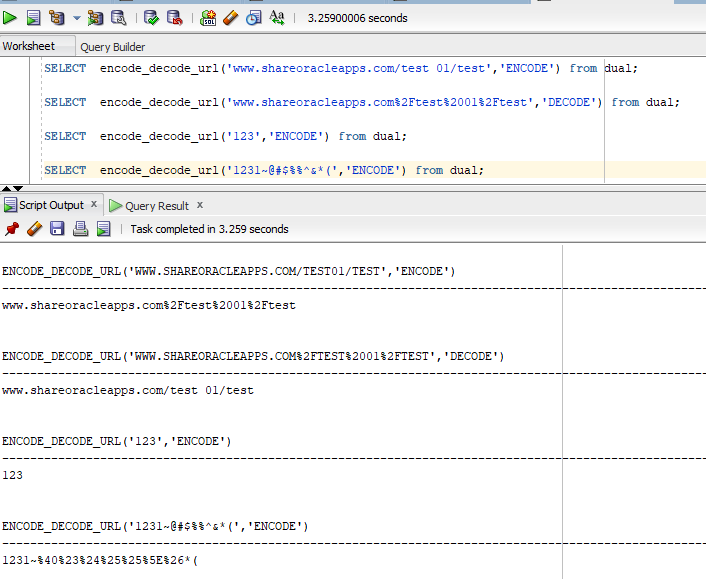
Automatic encoding and escaping functions are built into most frameworks. Start with using your framework’s default output encoding protection when you wish to display data as the user typed it in. This section covers each form of output encoding, where to use it, and where to avoid using dynamic variables entirely.
#Node url encode decode code
Variables should not be interpreted as code instead of text. Output Encoding is recommended when you need to safely display data exactly as a user typed it in. Output Encoding and HTML Sanitization help address those gaps. However, frameworks aren't perfect and security gaps still exist in popular frameworks like React and Angular. Frameworks make it easy to ensure variables are correctly validated and escaped or sanitised. Any variable that does not go through this process is a potential weakness. Ensuring that all variables go through validation and are then escaped or sanitized is known as perfect injection resistance. Each variable in a web application needs to be protected. XSS Defense Philosophy ¶įor XSS attacks to be successful, an attacker needs to insert and execute malicious content in a webpage. OWASP are producing framework specific cheatsheets for React, Vue, and Angular. This is where Output Encoding and HTML Sanitization are critical. There will be times where you need to do something outside the protection provided by your framework. Understand how your framework prevents XSS and where it has gaps. Out of date framework plugins or components.Angular’s bypassSecurityTrustAs* functions.React cannot handle javascript: or data: URLs without specialized validation.React’s dangerouslySetInnerHTML without sanitising the HTML.escape hatches that frameworks use to directly manipulate the DOM.That said, developers need to be aware of problems that can occur when using frameworks insecurely such as: These frameworks steer developers towards good security practices and help mitigate XSS by using templating, auto-escaping, and more. Framework Security ¶įewer XSS bugs appear in applications built with modern web frameworks. Using the right combination of defensive techniques is necessary to prevent XSS. This cheatsheet is a list of techniques to prevent or limit the impact of XSS. XSS is serious and can lead to account impersonation, observing user behaviour, loading external content, stealing sensitive data, and more. Since then, it has extended to include injection of basically any content, but we still refer to this as XSS. The name originated from early versions of the attack where stealing data cross-site was the primary focus. This cheat sheet provides guidance to prevent XSS vulnerabilities.Ĭross-Site Scripting (XSS) is a misnomer. Insecure Direct Object Reference PreventionĬross Site Scripting Prevention Cheat Sheet ¶ Introduction ¶ Output Encoding for “JavaScript Contexts”

Output Encoding for “HTML Attribute Contexts” This module provides utility methods for parsing and formatting URL query strings: const querystring = require ( 'querystring' ) const baseUrl = '' const query = 'SELECT * from users WHERE id = 1' // Encode query string const encodedQuery = querystring. You could also use the Node.js built-in querystring module to encode a URL.

#Node url encode decode full
Here is an example: const baseUrl = '' const query = 'SELECT * from users WHERE id = 1' // Encode query string const encodedQuery = encodeURIComponent (query ) // Build full URL const url = baseUrl + encodedQueryĬonsole. This method is suitable for encoding URL components such as query string parameters and not the complete URL. You should use the encodeURIComponent() method to encode special characters in URI components. log (encodedUrl ) // !Learn%20Node$/%20Example encodeURIComponent() Method The encodeURI() method encodes a complete URL, including encodes special characters except characters: const url = '!Learn Node$/ Example' // Encode complete URL const encodedUrl = encodeURI (url ) // Print encoded URLĬonsole. Since Node.js is a JavaScript runtime built on Chrome's V8 JavaScript engine, you can use JavaScript methods such as encodeURI() and encodeURIComponent() to encode a URL.
#Node url encode decode how to
In this article, you'll learn how to encode or decode a URL string and query string parameters in a Node.js application. It converts a string into a valid URL format making the transmitted data more reliable and secure. URL encoding is commonly used to avoid cross-site scripting (XSS) attacks by encoding special characters in a URL.


 0 kommentar(er)
0 kommentar(er)
